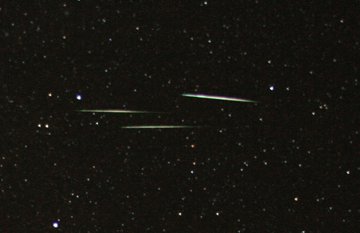 Where's Saturn? Is that a UFO--or the ISS? What's the name of that star? Get the answers from mySKY--a fun new astronomy helper from Meade. Where's Saturn? Is that a UFO--or the ISS? What's the name of that star? Get the answers from mySKY--a fun new astronomy helper from Meade. SUN BUZZ: The solar physics community is abuzz this week. No, there haven't been any great eruptions or solar storms. The source of the excitement is a modest knot of magnetism that popped up on the sun, possibly heralding the start of a new solar cycle: full story. SUNSPOT BREAKUP: Giant sunspot 978 is dispersing. The Solar and Heliospheric Observatory (SOHO) has been monitoring the spot and recorded this 9-day movie chronicling its evolution from birth to present: 
This is a good opportunity for amateur astronomers with backyard solar telescopes to watch a Jupiter-sized object break apart. more images: from Rogerio Marcon of Sao Paulo, Brazil; from the Hinode spacecraft in Earth orbit; from S. Johansen, J. Fairfull and John Stetson of South Portland, Maine; from Franck Charlier of Marines, Val d'Oise - France; from Alcaria Rego of Almada - Portugal; from Eric Soucy of Ohain, Brabant wallon, Belgium; from James Kevin Ty of Manila, the Philippines; GEMINIDS CONTINUED: If it's dark where you live, be alert for Geminids; although the the shower is subsiding, it is still producing some impressive meteors. "The Geminids were terriffic tonight (Dec. 15th)," reports airline pilot Dan Wood. "I just finished a trip from New Orleans and we got to watch the show through the airplane's windows. At times there were three or more Geminids per minute with seven or eight really bright green ones. I even saw a few while on the ground in Las Vegas--not the darkest place on the planet!" Half a world away, a similar flurry appeared over China: 
"More than one hundred people at the Beijing Planetarium enjoyed the glittering meteors," says photographer Xin Li. He combined ten photos taken with his Canon EOS 30D to produce a composite "meteor splash." Tracing the meteors backwards in time shows that they all come from a common radiant in the constellation Gemini. In Reno, Nevada, James Mangum "sprawled out in the snow and counted more than 80 meteors in an hour. One rust-colored fireball lasted nearly 4 seconds as it crossed the sky, leaving bits and pieces in its path. Others were quite bright and blue in color. Great shower!" 2007 Geminid Meteor Gallery
[World Map of Geminid Sightings]
[sky map] [meteor alerts] [Night Sky Cameras] | 
